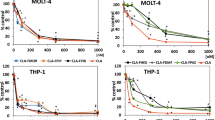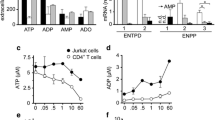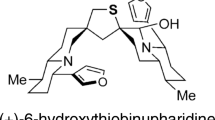Abstract
1,3-Dipropyl-8-cyclopentylxanthine (DPCPX), a xanthine analogue used as a selective antagonist of adenosine receptors, caused apoptosis in a variety of leukaemia-derived cell lines as well as in cells from patients with myeloid leukaemia. Apoptosis was assessed by flow cytometry, by DNA fragmentation and by accumulation of histones, H2A, H2B, R3 and H4, in the nucleoplasm of cells. Cell cycle analysis indicated that apoptosis occurred irrespective of the cell cycle phase. DPCPX did not trigger apoptosis in resting human peripheral blood lymphocytes; neither did it potentiate the apoptotic effect of phytohemagglutinin (PHA), when these cells were activated by PHA. These results indicate that DPCPX may be useful in the therapy of proliferative disorders of the hematopoietic system.
Similar content being viewed by others
References
Duvall E, Wyllie AH. Death and the cell. Immunol Today 1986; 7: 115–117.
Eastman A, Barry MA, Demarcq C. The involvement of the cell cycle in apoptosis. In: Hu VW, ed. The Cell Cycle: Regulators, Targets, and Clinical Applications. New York, NY (USA): Plenum Press, 1994: 369–378.
McConkey DJ, Hartzell P, Amador-Pérez JF, Orrenius S, Jondal M. Calcium-dependent killing of immature lymphocytes by stimulation via the CD3/T cell receptor complex. J Immunol 1989; 143: 1801–1806.
Rothenberg EV. Death and transfiguration of cortical thymocytes: A reconsideration. Immunol Today 1990; 11: 116–119.
McConkey DJ, Orrenius S, Jondal M. Cellular signalling in programmed cell death (apoptosis). Immunol Today 1990; 11: 120–121.
Cohen JJ. Apoptosis. Immunol Today 1993; 127: 126–130.
Hitchings GH. Biochemical approach to new medications. In: Harkness RA, Elion GB, Zöllner N, eds. Purine and Pyrimidine Metabolism in Man VII, Part A: Chemotherapy, ATP Depletion and Gout. New York, NY (USA): Plenum Press, 1991: 1–6.
Carrera CJ, Piro LD, Saven A, Beutler E, Terai C, Carson DA. 2-chlorodeoxyadenosine chemotherapy triggers programmed cell death in normal and malignant lymphocytes. In: Harkness RA, Elion GB, Zöllner N, eds. Purine and Pyrimidine Metabolism in Man VII, Part A: Chemotherapy, ATP Depletion and Gout. New York, NY (USA): Plenum Press, 1991: 15–18.
Robertson LE, Chubb S, Meyn RE, et al. Induction of apoptotic cell death in chronic lymphocytic leukemia by 2-chloro-2′-deoxyadenosine and 9-β-D-arabinosyl-2-fluoroadenine. Blood 1993; 81: 143–150.
Hentosh P, Grippo P. Template 2-chloro-2′-deoxyadenosine monophosphate inhibits in vitro DNA synthesis. Mol Pharmacol 1994; 45: 955–961.
Kizaki H, Suzuki K, Tadakuma T, Ishimura Y. Adenosine receptor-mediated accumulation of cyclic AMP-induced T-lymphocyte death through internucleosomal DNA cleavage. J Biol Chem 1990; 265: 5280–5284.
Szondy Z. Adenosine stimulates DNA fragmentation in human thymocytes by Ca2+-mediated mechanisms. Biochem J 1994; 304: 877–885.
Tanaka Y, Yoshihara K, Tsuyuki M, Kamiya T. Apoptosis induced by adenosine in human leukemia HL-60 cells. Exp Cell Res 1994; 213: 242–252.
Mirabet M, Mallol J, Lluis C, Franco R. Dipropylcyclopentylxanthine triggers apoptosis in Jurkat T cells by a receptor-independent mechanism. Cell Death Diff 1997; 4: 639–646.
Boyum A. Separation of leukocytes from blood and bone marrow. Scand J Clin Invest 1968; 21: 51–62.
Laurent-Crawford AG, Krust B, Muller S, et al. The cytopathic effect of HIV is associated with apoptosis. Virology 1991; 185: 829–839.
Darzynkiewicz Z, Bruno S, DelBino G, et al. Features of apoptotic cells measured by flow cytometry. Cytometry 1992; 13: 795–808.
Dive C, Gregory CD, Phipps DJ, Evans DL, Milner AE, Wyllie AH. Analysis and discrimination of necrosis and apoptosis (programmed cell death) by multiparameter flow cytometry. Biochim Biophys Acta 1992; 1133: 275–285.
Belloc F, Dumain P, Boisseau MR, et al. A flow cytometric method using Hoechst 33342 and propidium iodide for simultaneous cell cycle analysis and apoptosis determination in unfixed cells. Cytometry 1994; 17: 59–65.
Pederson DS, Thoma F, Simpson RT. Core particle, fiber and transcriptionally active chromatin structure. Annu Rev Cell Biol 1986; 2: 117–147.
Biknell GR, Cohen GM. Cleavage of DNA to large kilobase pair fragments occurs in some forms of necrosis as well as apoptosis. Biochem Biophys Res Comm 1995; 207: 40–47.
Müller CE, Scior T. Adenosine receptors and their modulators. Pharmaceutica Acta Helvetiae 1993; 68: 77–111.
Ormerod MG, Sun XM, Snowden RT, Davies R, Fearnhead H, Cohen G. Increased membrane permeability of apoptotic thymocytes: A flow cytometric study. Cytometry 1993; 14: 595–602.
Ellwart JW, Dörmer P. Viability measurement using spectrum shift in Hoechst stained cells. Cytometry 1990; 11: 239–243.
Gorczyca W, Gong J, Ardelt B, Traganos F, Darzynkiewicz Z. The cell cycle related differences in susceptibility of HL-60 cells to apoptosis induced by various antitumor agents. Cancer Res 1993; 53: 3186–3192.
Dunn NL, Maurer HM. Enzyme alterations in leukemic cells. Am J Hematol 1982; 13: 343–351.
Marijnen YMT, de Korte D, Haverkort WA, den Breejen EJS, van Gennip AH, Roos D. Studies on the incorporation of precursors into purine and pyrimidine nucleotides via ‘de novo’ and "salvage’ pathways in normal lymphocytes and lymphoblastic cell-line cells. Biochim Biophys Acta 1989; 1012: 148–155.
Rights and permissions
About this article
Cite this article
Mirabet, M., Mallol, J., Lluis, C. et al. Dipropylcyclopentylxanthine triggers apoptosis in cells from patients with myeloid leukaemia. Apoptosis 3, 183–193 (1998). https://doi.org/10.1023/A:1009650906376
Issue Date:
DOI: https://doi.org/10.1023/A:1009650906376




